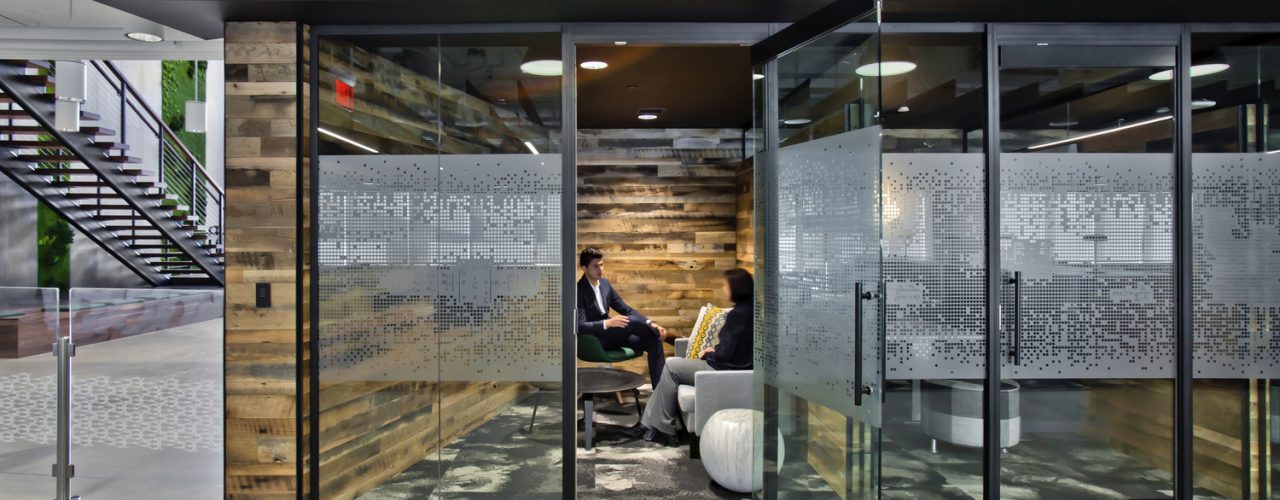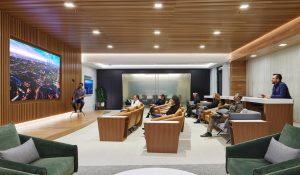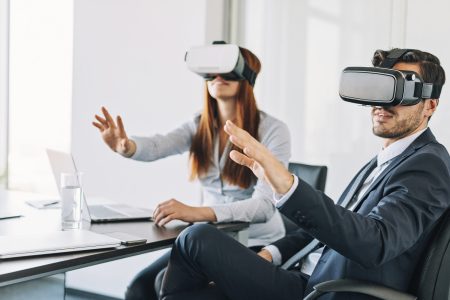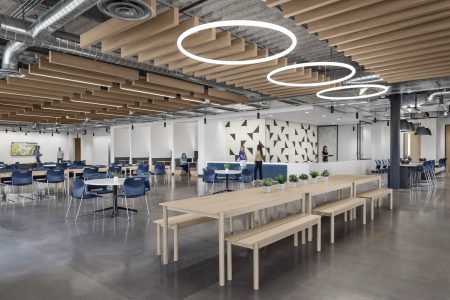Neurodiversity in the Workplace is Redefining How Companies Operate

RSP designer Kelsey Sullivan NCIDQ, WELL AP, IIDA explains how and why employers are accommodating and celebrating neurodiversity in the workplace, making work life better for everyone.
This article was originally published in Work Design Magazine.
Up to 20% of the population falls into the category of neurodivergent. Conditions and differences that used to carry a stigma are now becoming more accepted, even celebrated, at school, at work and in personal relationships. But first, let’s define what it is. “Neurodivergent” is a non-medical term to describe differences in brain function due to a variety of factors. Neurodivergence is not the same as disability or mental illness, but they can be associated.
Some of the most common differences that fall into this category are Autism Spectrum Disorder, ADHD, and Dyslexia (difficulty with reading). It can also include Dyspraxia (difficulty with coordination), intellectual disability and sensory processing disorders. These conditions can co-occur, leading to complex (and sometimes missed) diagnoses and treatments. All of these are spectrum disorders that affect people differently, where individuals are on a sliding scale of difficulty with integrating into a neurotypical world. Many neurodivergent individuals face discrimination and often have a higher-than-average unemployment rate compared to their neurotypical peers. But neurodivergent people have incredible potential and can have extraordinary careers (Steve Jobs, Simone Biles, and Tim Burton, to name a few) when given the right support and accommodations.
The Superpowers Behind Neurodiversity in the Workplace
Neurodiversity can also come with special abilities—abilities that are valuable not just for individuals, but for entire organizations. For example, research shows that autism and dyslexia can give people skills in pattern recognition, memory and mathematics. Other studies found that neurodiverse teams are 30% more productive than neurotypical ones and made fewer errors.
According to a Harvard study, people with Autism perform highly thorough and attentive work. They prefer routine to novelty and exhibit steady focus and repetitive behavior patterns. The University of Michigan found that people with dyslexia tend to have out-of-the-box thinking. They process information visually and are good at finding hidden connections, making them ideal to discover patterns and trends in data. Researchers from the University of Memphis and the University of Michigan found that people with ADHD are more creative compared to their peers. They tend to work well under pressure, be very proactive and are better at adjusting to change. They also have the ability to be hyper-focused on topics that interest them.
Harnessing the Power
Greater innovation, creativity, accuracy, productivity, and employee retention? These are some of the biggest issues facing stagnating companies, not to mention those wrestling with remote workforces and hybrid work models. Becoming more inclusive of neurodiversity in the workplace can be a major part of the solution. There are a few policies companies can put into place in the near-term, and other accommodations that may take longer but are worth it in the long run.
An organizational culture that welcomes neurodiversity in the workplace needs to stem from policies and core values. Leadership support is required for any top-down culture shift, and this is no exception. Promoting flexibility, from a lenient dress code that addresses sensory concerns to core hours and hybrid work opportunities, are great first steps. Managers and leaders should be trained in avoiding harmful myths and stereotypes about neurodiversity in the workplace, as well as ways they can develop and nurture the unique characteristics and work styles of everyone on their team, neurotypical and neurodivergent alike. Everyone should have access to resources and support through mentorship and mental health programs.
A few other helpful accommodations: noise-canceling headphones, policies that allow individuals to listen to music, the acceptance of fidget tools, the ability to take frequent, shorter breaks, scheduling reoccurring touchpoints to review task priorities and break down larger project milestones, and providing meeting notes, tasks and expectations in written form.
How the Built Environment Can Support Neurodiversity in the Workplace
In my years of workplace design experience, I see more and more clients pursuing greater inclusion in the office and it has only benefited the design process. As designers and workplace strategists, one of the most important things we’ve learned is that designing spaces for neurodivergent populations means being thorough and thoughtful about how people experience space. And that makes design better for everyone.

Sensory processing challenges and differences often accompany autism and ADHD. And in fact, many neurotypical people deal with sensory challenges, perhaps without realizing it. Getting distracted by too much (or too little) noise, becoming overwhelmed with lighting or temperature disturbances, or disliking how certain furniture fits their body or how fabrics feel against the skin, are some common examples. In the workplace, that can translate into zones for different types of work. Focus rooms are great for heads-down space, privacy, and sound control, while “War Rooms” or “Sandboxes” are higher-stimulation spaces ideal for group work and socializing. We are also designing more Wellbeing rooms with comfortable furnishings, textures and soft lighting for short breaks and sensory recalibration.
Utilizing clear wayfinding techniques through visual landmarks and color help make spaces more memorable and reduce the potential for visual overload. Wider corners and corridors can be helpful for people with dyspraxia and those who dislike physical contact. Most importantly, promoting individualization is key in accommodating the vast differences and performance preferences between employees. Things like sit-stand desks and encouraging movement through policy and layout design can keep all employees active and engaged. Incorporating adjustable lighting and temperature control opportunities at each workspace can increase employee morale and productivity. And the use of biophilia and natural light throughout an office environment can give a proven mental health boost.
In terms of technology, text-to-speech and speech-to-text software can be a gamechanger for some employees. Similarly, transcription tools for meetings, closed captions for virtual meetings, AI tools, time-tracking and reminder apps can all benefit employees with different needs and work styles. The most important thing to remember is not make assumptions—all individuals, neurodivergent or neurotypical, have distinct needs and challenges. It’s best to make these options available and allow employees to decide how and when to use them.
An Inclusive Workplace is a Successful Workplace
We know that organizations that embrace diversity are more successful. It’s evident when looking at the number of major companies that pride themselves on welcoming a diverse workforce (SAP, Microsoft, UBS, and JPMorgan Chase, to name just a few). Research has found that companies with more diverse leadership report revenues 19% higher than organizations with below-average diversity in leadership positions.
Younger employees are accepting and embracing neurodiversity in ways their predecessors didn’t. A rise in awareness of different neurodivergent conditions, challenges, preferences, and special abilities will continue to make this a leading issue for organizations around the world. Getting ahead of it through embracing inclusivity and neurodiversity in the workplace now is one of the best ways to stay competitive in an increasingly complex world.
About the Author
Kelsey Sullivan TX RID, MN CID, NCIDQ, WELL AP, IIDA is a Senior Project Interior Designer at RSP Architects in Fort Worth, TX with more than a decade of experience in workplace design and strategy. Her ongoing work involves collaborating with a large, international client focused on designing modern, high-performing workplaces. Her credentials as a WELL AP certified professional give her a holistic view of the future of the workplace. Read more about Kelsey on LinkedIn.
Featured Image: Confidential Client | Photo by Gilbertson Photography


